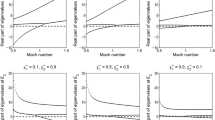A mathematical description of the evaporation of a binary solution from the free surface of a spill has been proposed. Results of experimental study on the evaporation of hydrochloric acid in a wind tunnel have been presented. It has been established that the resistance of the evaporating component to transfer in the liquid phase exerts a substantial influence in the intensity of evaporation of hydrochloric acid. The effective diffusion coefficient has been determined experimentally, which allows for the influence of the resistance to mass transfer in the liquid phase on the intensity of evaporation of the solution.
Similar content being viewed by others
References
T. Vik and Reif B. A. Pettersson, Implementation of a New and Improved Evaporation Model in Fluent, FFI-rapport 2011/00116, Norwegian Defence Research Establishment (FFI) (2011).
M. Lateb, C. Masson, T. Stathopoulos, and C. Bedard, Numerical simulation of pollutant dispersion around a building complex, Build. Environ., 45, No. 8, 1788–1798 (2010).
Y. Tominaga and T. Stathopoulos, Numerical simulation of dispersion around an isolated cubic building: model evaluation of RANS and LES, Build. Environ., 45, No. 10, 2231–2239 (2010).
S. M. Tauseef, D. Rashtchian, and S. A. Abbasi, CFD-based simulation of dense gas dispersion in presence of obstacles, J. Loss Prevent. Process Ind., 24, No. 4, 371–376 (2011).
P. W. M. Brighton, Evaporation from a plane liquid surface into a turbulent boundary layer, J. Fluid Mechanics, 159, 323–345 (1985).
A. Habib, B. Schalau, A. Acikalin, and J. Steinbach, Transient calculation of the boundary layer flow over spills, Chem. Eng. Technol., 32, No. 2, 306–311 (2009).
S. Khajehnajafi and R. Pourdarvish, Correlations for mass transfer from a liquid spill: comparisons and recommendations, Process Saf. Prog., 30, No. 2, 178–184 (2011).
F. Heymes, L. Aprin, A. Bony, S. Forestier, S. Cirocchi, and G. Dusserre, An experimental investigation of evaporation rates for different volatile organic compounds, Process Saf. Prog., 32, No. 2, 193–198 (2013).
A. D. Galeev and S. I. Ponikarov, Numerical analysis of the process of heated oil evaporation from the emergency spill surface, Inzh.-Fiz. Zh., 84, No. 6, 1297–1305 (2011).
M. F. Fingas, Studies on the evaporation of crude oil and petroleum products: I. The relationship between evaporation rate and time, J. Hazard. Mater., 56, No. 3, 227–236 (1997).
M. F. Fingas, Studies on the evaporation of crude oil and petroleum products: II. Boundary layer regulation, J. Hazard. Mater., 57, Nos. 1–3, 41–58 (1998).
M. F. Fingas, Modeling evaporation using models that are not boundary layer regulated, J. Hazard. Mater., 107, Nos. 1, 2, 27–36 (2004).
K. Okamoto, N. Watanabe, Y. Hagimoto, K. Miwa, and H. Ohtahi, Evaporation characteristics of multi-component liquid, J. Loss Prevent. Process Ind., 23, No. 1, 89–97 (2010).
S. R. Hanna and P. J. Drivas, Modeling VOC emissions and air concentration from the Exxon Valdez oil spill, Air & Waste, 43, No. 3, 298–309 (1993).
P. Leonelli, C. Stramigioli, and G. Spadoni, The modeling of pool vaporization, J. Loss Prevent. Process Ind., 7, No. 6, 443–450 (1994).
J. L. Mikesell, A. C. Buckland, V. Diaz, and J. J. Kives, Evaporation of contained spills of multicomponent nonideal solutions, in: Proc. Int. Conf. and Workshop on Modeling and Mitigating the Consequences of Accidental Releases of Hazardous Materials, CCPS, AIChE, 1991, pp. 103–125.
G. Desoutter, C. Habchi, B. Cuenot, and T. Poinsot, DNS and modeling of the turbulent boundary layer over an evaporating liquid film, Int. J. Heat Mass Transf., 52, Issues 25–26, 6028–6041 (2009).
A. D. Galeev, E. V. Starovoitova, and S. I. Ponikarov, Numerical simulation of the formation of a toxic cloud on outpouring ejection of liquefied chlorine to the atmosphere, Inzh.-Fiz. Zh., 84, No. 1, 203–212 (2013).
A. Blanchard and D. Hadlock, Source Term Determination for Spills of Binary Liquid Solutions, Technical Report WSRC-TR-96-0404, Westinghouse Savannah River Company (1997).
A. D. Galeev, A. A. Salin, and S. I. Ponikarov, Consequence analysis of aqueous ammonia spill using computational fluid dynamics, J. Loss Prevent. Process Ind., 26, No. 4, 628–638 (2013).
D. W. Green and R. H. Perry, Chemical Engineer's Handbook, 8th ed., McGraw-Hill (2008).
Fluent Inc. Fluent 6.1. User's Guide, Lebanon (2003).
C. K. Law, Combustion Physics, Cambridge University Press (2006).
A. D. Galeev, E. V. Starovoytova, and S. I. Ponikarov, Numerical simulation of the consequences of liquefied ammonia instantaneous release using FLUENT software, Process Safety Environ. Protect., 91, No. 3, 191–201 (2013).
T. H. Shih, W. W. Liou, A. Shabbir, and J. Zhu, A new k–ε eddy-viscosity model for high Reynolds number turbulent flows — model development and validation, Comput. Fluids, 24, No. 3, 227–238 (1995).
H. Schlichting, Boundary-Layer Theory, 6th ed., McGraw-Hill, New York (1968).
F. P. Incropera, D. P. DeWitt, T. L. Bergman, and A. S. Lavine, Fundamentals of Heat and Mass Transfer, Wiley (2006).
Author information
Authors and Affiliations
Corresponding author
Additional information
Translated from Inzhenerno-Fizicheskii Zhurnal, Vol. 87, No. 3, pp. 730–738, May–June, 2014.
Rights and permissions
About this article
Cite this article
Salin, A.A., Galeev, A.D. & Ponikarov, S.I. Study of the Evaporation of Hydrochloric Acid: Modeling and Experiment. J Eng Phys Thermophy 87, 753–762 (2014). https://doi.org/10.1007/s10891-014-1069-2
Received:
Published:
Issue Date:
DOI: https://doi.org/10.1007/s10891-014-1069-2



